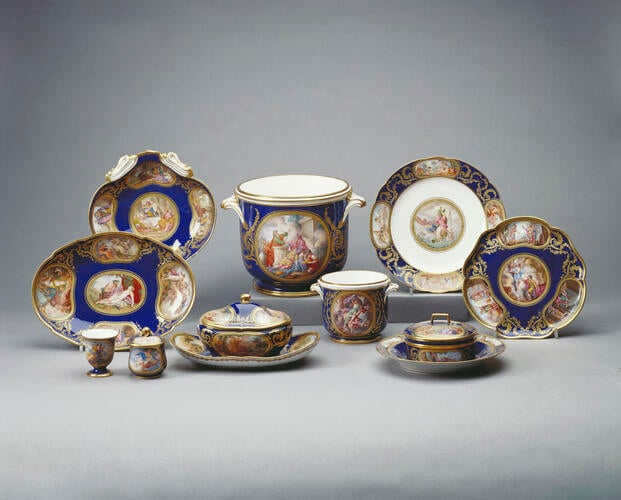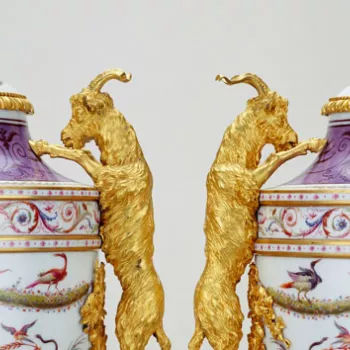The Louis XVI dinner service 1783-93
Soft-paste porcelain, beau bleu ground and gilded decoration | Given on individual item records (whole object) | RCIN 5000017

Sèvres porcelain factory
The Louis XVI dinner service 1783-93

Sèvres porcelain factory
The Louis XVI dinner service 1783-93

Sèvres porcelain factory
The Louis XVI dinner service 1783-93



-
This service, of which the items in the Royal Collection form part, was the most costly and sumptuous ever created at Sèvres in the eighteenth century. It was intended to take 23 years to complete and was the swansong of the great services produced in soft-paste porcelain at Sèvres. It was commissioned by Louis XVI in 1783 for his personal use at Versailles but only 197 pieces had been made when production was brought to a halt following the execution of the King in 1793.
Painted with a bleu nouveau ground and reserves with scenes taken from mythology and Greek and Roman history, the service was largely conceived as a showpiece and was not intended for general use. When completed, it was to include 60 plates (30 delivered) without painted decoration; they were clearly intended for use. Special purchases of engravings were made by the manufactory for the artists to copy. These included complete series of illustrations from the Paris editions of Ovid's Métamorphoses and Fénelon's Les Aventures de Télémaque (1773).
Each plate cost an unprecedented 480 livres, the most costly element was the painting of the scenes. For example, it was estimated that the painting of one large tureen tray would cost 1,200 livres and would require one artist to work 8-10 hours per day for 12-15 months in order to paint the four reserves.
From Sèvres Porcelain in the Collection of Her Majesty The Queen: The Louis XVI Service
Provenance
Commissioned by Louis XVI in 1783, the majority of the pieces from the service were purchased by the Prince Regent from Mr. Würtz of Paris in 1811 for £1,973 4s 8d, though the dealer, Robert Fogg. Recorded in the porcelain inventory at Carlton House in c.1827, no.128.
In addition, Queen Mary acquired two juice pots between 1932-37 and in 1959 Sir Stephen Lycett Green (1910-96) presented four pieces to Queen Elizabeth II. -
Creator(s)
(porcelain manufacturer)(nationality)(author)(porcelain painter)(porcelain painter)(porcelain painter)(porcelain painter)Acquirer(s)
Commissioner(s)
-
Medium and techniques
Soft-paste porcelain, beau bleu ground and gilded decoration
Measurements
Given on individual item records (whole object)
Category
Place of Production
Sèvres [France]








